Special Report
What the US Army's Uniform Looked Like in Every War Since 1775

Published:

Predating the Declaration of Independence by over a year, the U.S. Army was officially established in June 1775. Not only the oldest branch in the U.S. military, the Army is also the largest, with nearly half a million active duty servicemen and women. The Army’s stated purpose is to engage in sustained combat, establish land dominance, and seize control of enemy resources. While the mission has changed little over the course of the branch’s nearly 250-year history, the tools, equipment, and clothing necessary to accomplish it have. (Here’s a look at the size of the American military every year since the Korean War.)
The U.S. Army is undergoing a modernization strategy that involves shifting priorities and developing new technologies, weapons, and hardware to better meet the demands of future combat scenarios. The current initiative, known as the Army Modernization Strategy, began in 2019, and it is only the latest in a long series of overhauls designed to ensure America’s largest fighting force remains effective, and as safe as possible, on the battlefield.
In addition to the Army’s continuous modernization efforts, the demands of the various wars the United States has been involved in – related not only to fighting, but also climate and terrain – have also contributed to the evolution of what American soldiers wear and carry in combat.
Using data from the U.S. Department of Defense’s report “Common Threads: Army,” 24/7 Tempo identified what the Army has worn in each major war – from the American Revolution to the modern era. For each conflict, we reviewed the uniforms, headwear, and footwear worn, as well as other equipment carried, by the typical serviceman or -woman. Our list is not exhaustive, but presents simplified descriptions of the uniforms worn by enlisted combat troops in a select number of major conflicts involving the United States.
Click here to see what the U.S. Army’s uniform has looked like in every war since 1775
In the earliest days of the U.S. Army, combat uniforms closely resembled those worn by European military powers, particularly Britain and France. Some of the biggest changes to military attire came in the early 20th century, when helmets were introduced and trousers and shirts became a single matching color. In the late 20th century and into the modern era, combat uniforms began incorporating more protective gear and advanced technology, including Kevlar vests and helmets with greater bullet-resistance, capable of integrating communication devices and night vision goggles.
The climate and terrain of combat areas also had a major impact on troop clothing. In the early decades of the U.S. Army, uniforms were typically made from wool for cold-weather combat, and linen for warmer weather. While fighting in the Korean War necessitated warmer uniforms than those used in the Second World War, the tropical climes in the jungles of Vietnam required lighter uniforms, which often incorporated camouflage patterns. (Here’s every standard issue U.S. military rifle since the American Revolution.)

1. Revolutionary War Era (1775-1783)
> Headwear: A black felt cocked hat with wool tape around the brim – white for foot soldiers, yellow for artillery troops.
> Clothing: Dark blue wool coat worn over a single-breasted waistcoat with a standing collar and a white-collared loose-fitting long-sleeve shirt. Continental Army soldiers also wore white wool overalls in winter and white linen overalls in summer. These uniforms, which closely resembled styles used by the French and British militaries, were standardized in 1779, though not always available.
> Footwear: Low-top black leather shoes that were fastened with either a buckle or laces.
> Other equipment: A cartridge box for ammunition, usually containing about 24 rounds; a square linen knapsack for holding clothing; personal items; a blanket; another linen bag for carrying food and utensils; a canteen; and a bayonet scabbard.
[in-text-ad]
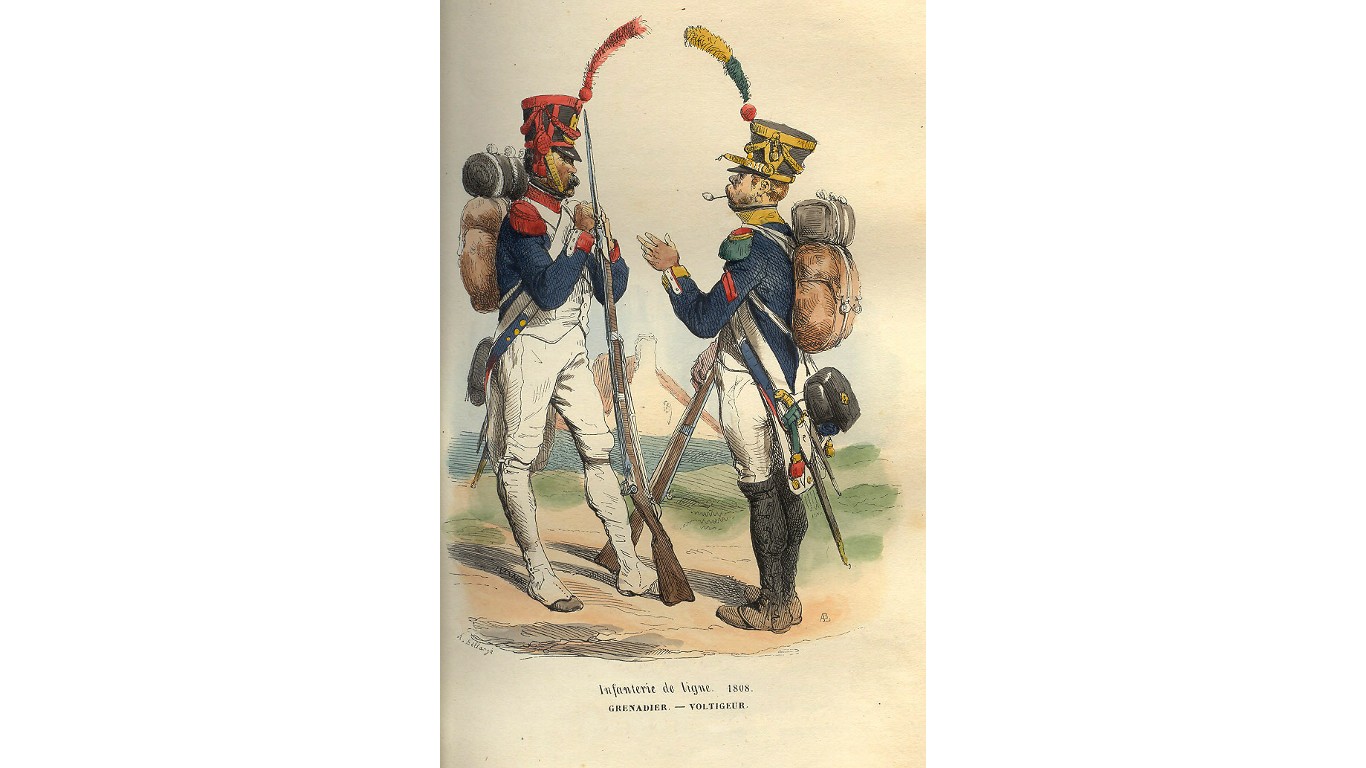
2. War of 1812 (1812-1815)
> Headwear: A tall black flat-top “tombstone” cap, originally made from felt, later from leather. These hats featured a plate denoting the insignia of the unit, a white wool plume, and a braided cord – yellow for artillery troops and white for infantry.
> Clothing: A waist-length coat fastened with 10 metal buttons, featuring short tails down the back. Regulation versions of these coats were in dark blue, but gray, brown, and green wools were also used due to dye shortages. Under the coat, soldiers wore a vest – linen in summer, wool in winter – with a high standing collar. Shirts were generally loose-fitting and had long sleeves and large collars. Trousers were tight-fitting around the legs and ankles – white linen in summer, and blue, white, or gray wool in winter – and were worn with black gaiters from the ankle to just below the knee to keep dirt out of the soldier’s shoes.
> Footwear: Black leather shoes with soles attached with wooden pegs and linen stitching.
> Other equipment: A three-compartment cartridge box for ammunition, spare flints, and a musket tool and cleaning rag. Also, a linen knapsack, painted for waterproofing, for holding clothing; personal items; a blanket; and another linen bag for carrying food and utensils. Soldiers also carried a canteen and a bayonet scabbard.
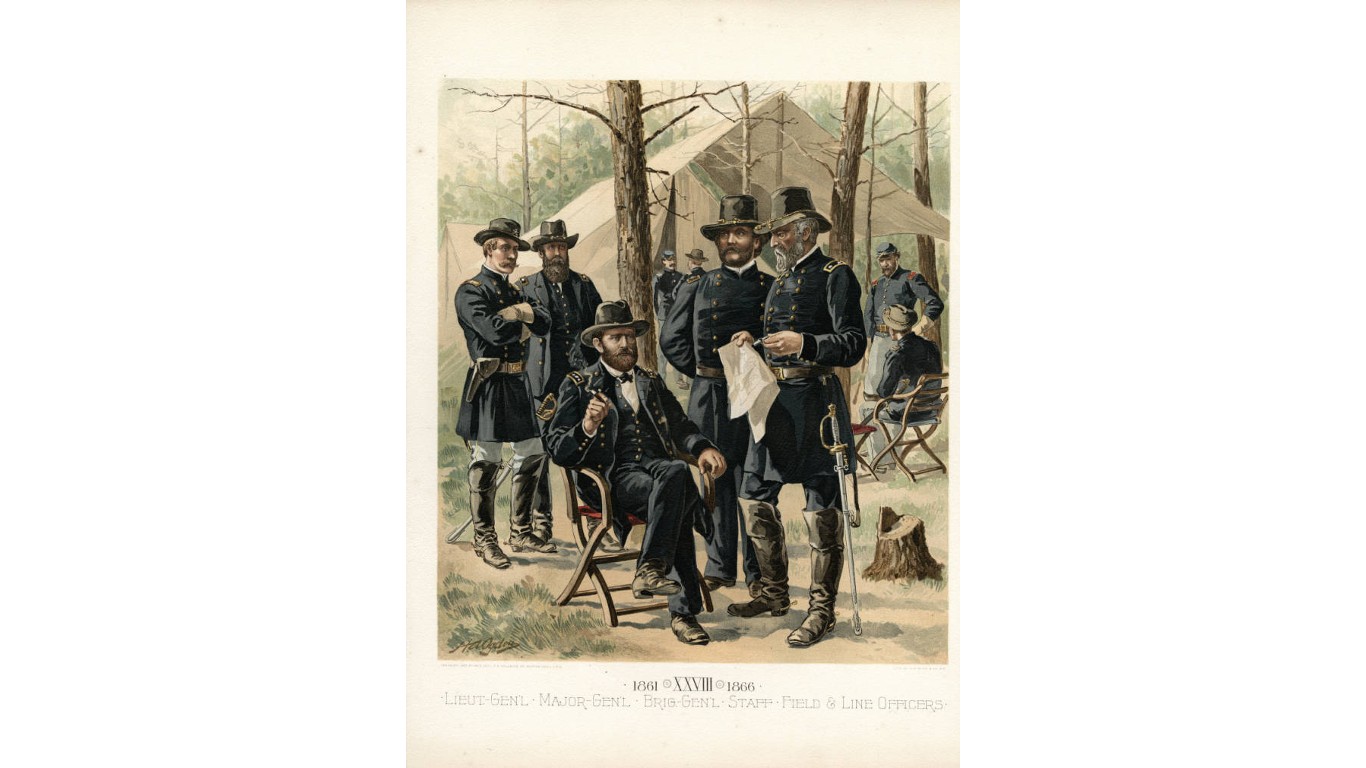
3. Civil War (1861-1865)
> Headwear: The M1858 army hat worn by Union troops in this period was made of black felt and had a three-inch brim held up on one side with a brass eagle. These hats also featured a branch insignia and, on the front, a hunting horn with the troop’s regiment number and company letter.
> Clothing: Most troops were issued a sack coat that hung just below the waistline, intended to be used for work or detail, made of dark blue wool and fastened by four brass buttons. They were also issued a dress coat, also made of dark blue wool, but longer, hanging halfway down the thigh. The coat was fastened with nine brass buttons and featured a standing collar and pointed cuffs. Shirts were pullover, and made of either cotton or a cotton-wool blend. Trousers were straight cut and made of blue wool with vertical side pockets.
> Footwear: Ankle-high lace-up shoes made of black leather, commonly known as Jefferson bootees.
> Other equipment: A black waist belt with a brass buckle stamped with “U.S.,” holding a black leather pouch for carrying percussion caps. On their backs, soldiers wore black cotton double-bag knapsacks containing clothing, personal items, a blanket, and a tent. Soldiers also carried a haversack with rations and eating utensils, as well as the M1858 tin canteen. Ammunition was held in an M1861 cartridge box, made from black leather, with a capacity for 40 .58 caliber rounds of ammunition.

4. World War I (1917-1918)
> Headwear: An olive green helmet with a rounded top and a flared brim around the circumference, intended to deflect shrapnel, but not bullets. The helmet also featured a leather lining and a chin strap
> Clothing: The M1912 and M1917 service uniforms used by the American Expeditionary Force in World War I were olive drab in color and made of wool with a cotton liner, and had a short standing collar. They were equipped with four pockets with enclosing flaps and were fastened with five buttons. Later iterations had the regimental number, company letter, and branch insignia. Soldiers also wore flannel pullover shirts with reinforced elbows and two pockets. Trousers were tapered at the lower leg and laced up at the bottom. Wool leg wraps were worn around the shins as protection from underbrush and mud.
> Footwear: M1917 trench boots were ankle high lace-ups made of cowhide, which ultimately proved inadequate on the battlefield. They were replaced by M1918 trench boots, which were sturdier and featured steel heel plates and toe caps, as well as hobnails for improved traction.
> Other equipment: A bandoleer with a shoulder strap and six pockets, each with a capacity for two spare ammo clips; an M1910 cartridge belt, made of canvas and brass, for carrying ammunition; a canteen and cup; and a first aid kit. Additionally, many soldiers carried a gas mask in a canvas haversack worn on the chest. On their backs, soldiers wore the M1910 haversack, made from canvas, containing an M1910 entrenching tool and an M1907 bayonet and scabbard. The pack was also used for carrying a meat pan, sewing kit, spare clothing, blankets, and a shelter.
[in-text-ad-2]
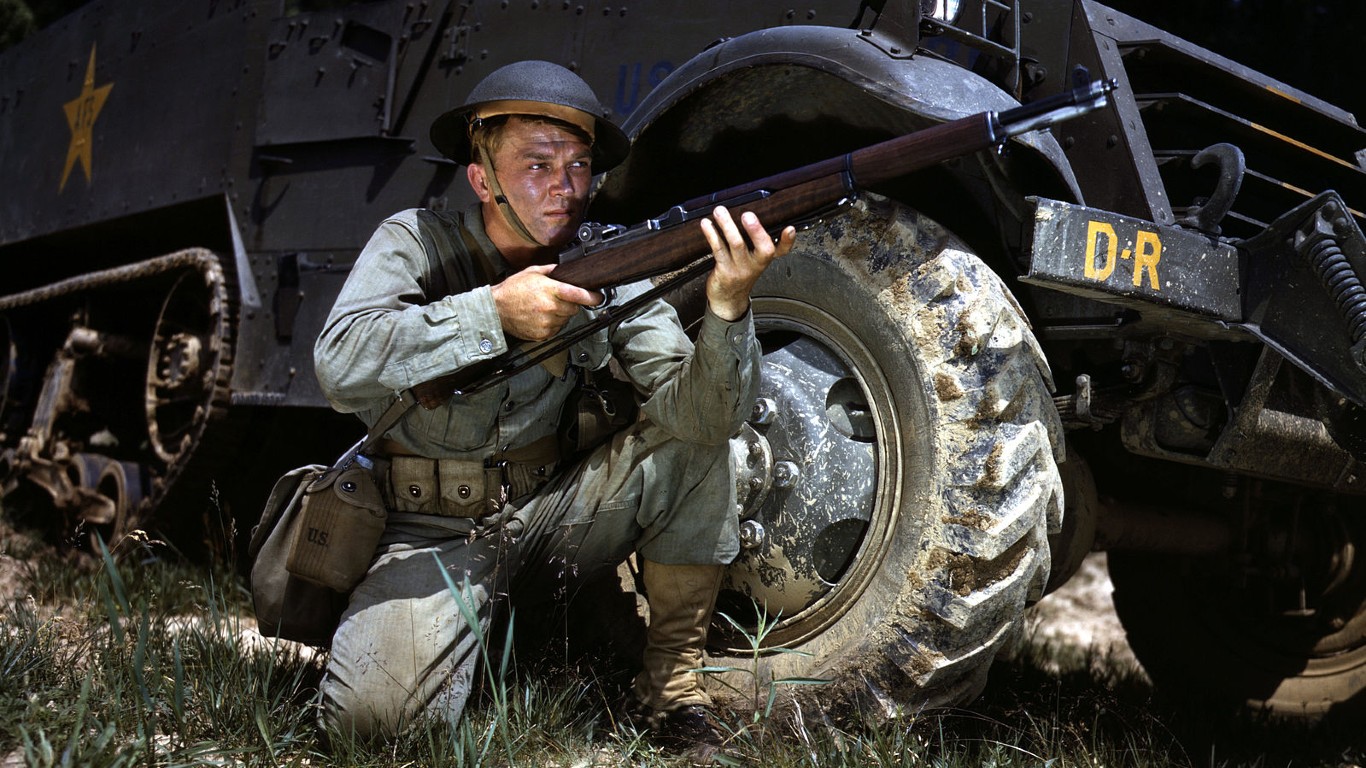
5. Early World War II (1941-1943)
> Headwear: The M1 helmet, made of manganese steel, offered better protection than the helmets used in WWI, but were still not bulletproof. They were olive drab with a finish that reduced reflective glare. They were held on with a two piece chinstrap and lined with a plastic-cotton mixture that molded to fit a soldier’s head.
> Clothing: In 1941, American troops in the European theater wore an olive drab cotton-poplin jacket lined with wool flannel. It was fastened with a zipper and featured a roll collar and slanted front button pockets. Trousers were the same color and made of wool. They featured diagonal side pockets, a single rear pocket, and a button fly. Cotton canvas leggings were worn over the shin.
> Footwear: Ankle-high leather shoes with rubber soles. In the Pacific theater, soldiers wore lace up canvas jungle boots. In the winter, soldiers wore rubber boots with a felt liner.
> Other equipment: In the early years of the war, American soldiers wore a six pocket bandoleer over the shoulder to carry spare ammunition clips. They also carried mittens with a trigger finger, and a haversack featuring quick release buckles along with an entrenching tool.
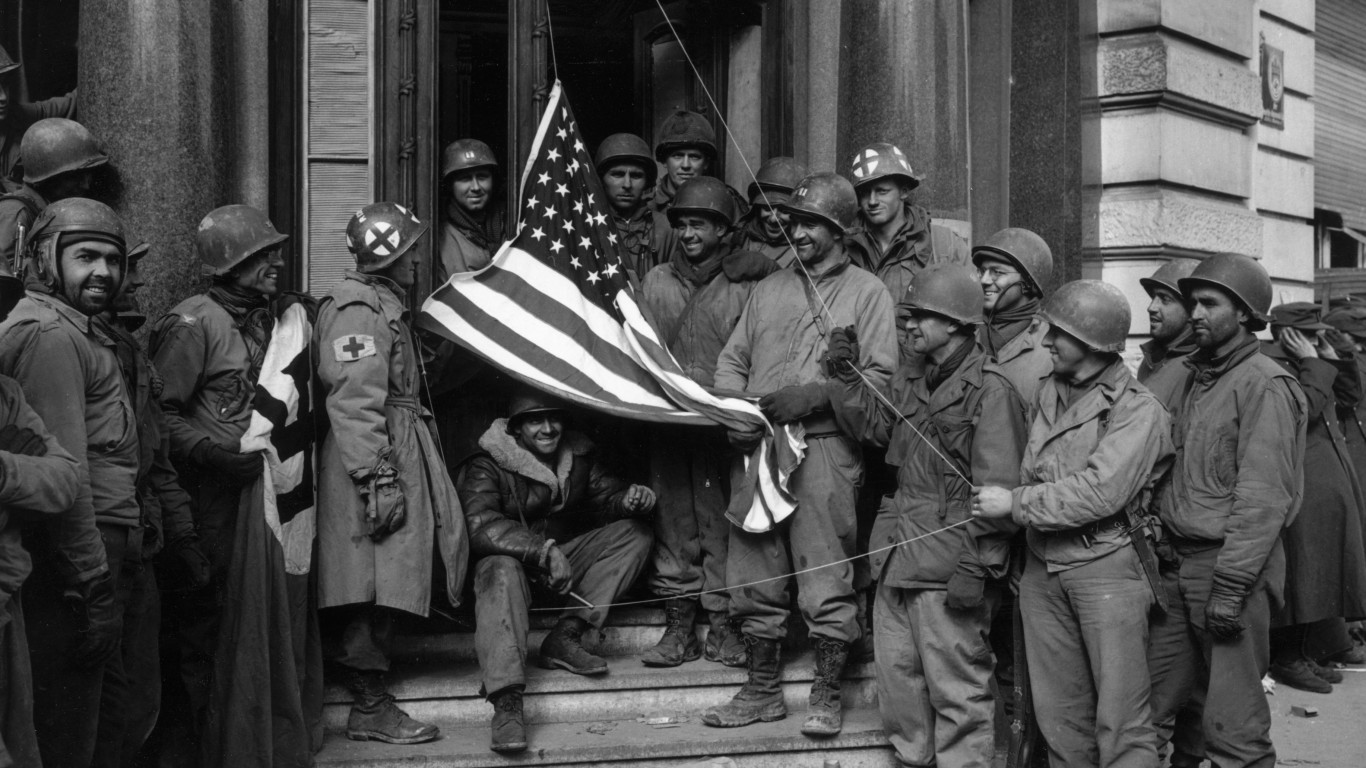
6. Late World War II (1943-1945)
> Headwear: In the second half of the war, U.S. troops still wore the M1 helmet.
> Clothing: In 1943, the U.S. military switched to a darker shade of green for field jackets and added two interior pockets, a detachable hood, a cotton-poplin liner, and a synching tie for an improved fit. These jackets were also more resistant to the elements. Trousers were also changed to match the darker color and could be worn over wool trousers in the winter. In the Pacific, troops wore reversible uniforms – green for jungle combat on one side, and tan for beach combat on the other. Jackets were herringbone twill cotton for the warmer climate and were fastened with five buttons. Trousers were made of the same material and featured a large flap cargo pocket.
> Footwear: In the middle of the war, the U.S. military switched to the M1943 combat boot, which still featured rubber soles, but also had a two-buckle leather cuff over the shin.
> Other equipment: Soldiers generally carried the M1923 cartridge belt with 10 pockets for extra rifle magazines. These belts also featured metal grommets to attach other equipment, like canteens, cups, a first aid pouch, and a cotton canvas cover. Soldiers also carried a dinner K-ration in their left breast pocket, an M6 gas mask carrier, and a bandoleer with extra ammunition. On their backs, soldiers carried the improved M1943 entrenching shovel. Late in the war, the improved M1945 combat and cargo pack were distributed in limited numbers.
[in-text-ad]
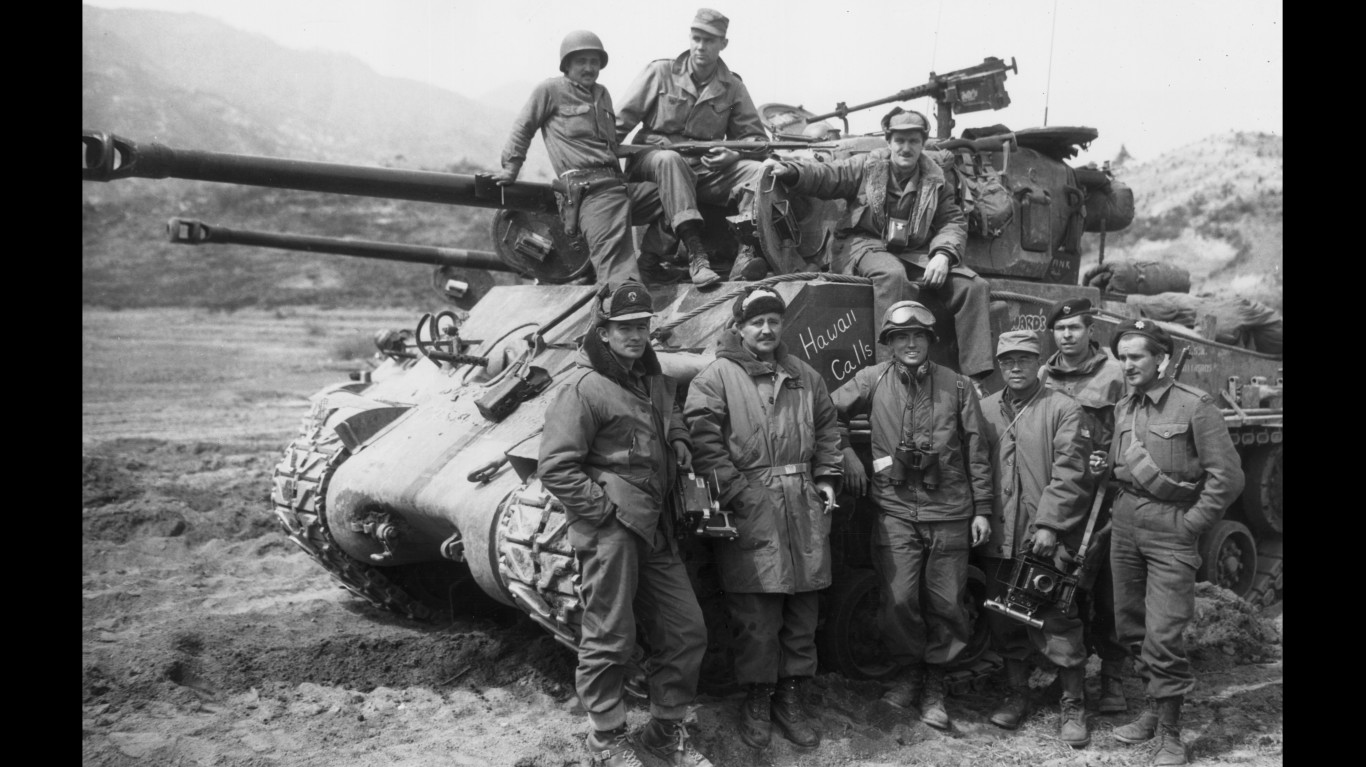
7. Korean War (1950-1953)
> Headwear: The helmets of the Korean War were similar to those used in World War II, and were worn with M1943 and M1951 field caps, which were cotton-poplin and wool, lined with ear flaps, and designed for cold, wet weather conditions.
> Clothing: Military uniforms of this era included many revised patterns from World War II, but with added cold-weather gear for the mountainous terrain and cold climate. These included olive drab overcoats and ponchos as well as the M1951 parka with a fur-lined hood and removable insulation. Other cold weather garments included water resistant leather gloves, insulated mittens, wool socks to wear over cotton socks, and M1951 wool and field trousers with a detachable liner.
> Footwear: In addition to M1943 combat boots from the previous era, Americans in the Korean War wore M1949 combat boots, which were high-top leather lace ups. In 1951, these were replaced by insulated rubber combat boots.
> Other equipment: American troops typically carried an OD canvas combat pack containing food, tools, and clothing, with external attachments for carrying an entrenching shovel, an M1 bayonet, a sleeping bag, and an overcoat. An OD field cargo pack containing a tent-like shelter could also be attached. Many troops also carried the M9A1 field protective mask for defense against harmful gasses. Troops were also issued the M1945A armor body fragmentation protective vest made with 12 layers of ballistic nylon and webbing to carry grenades.
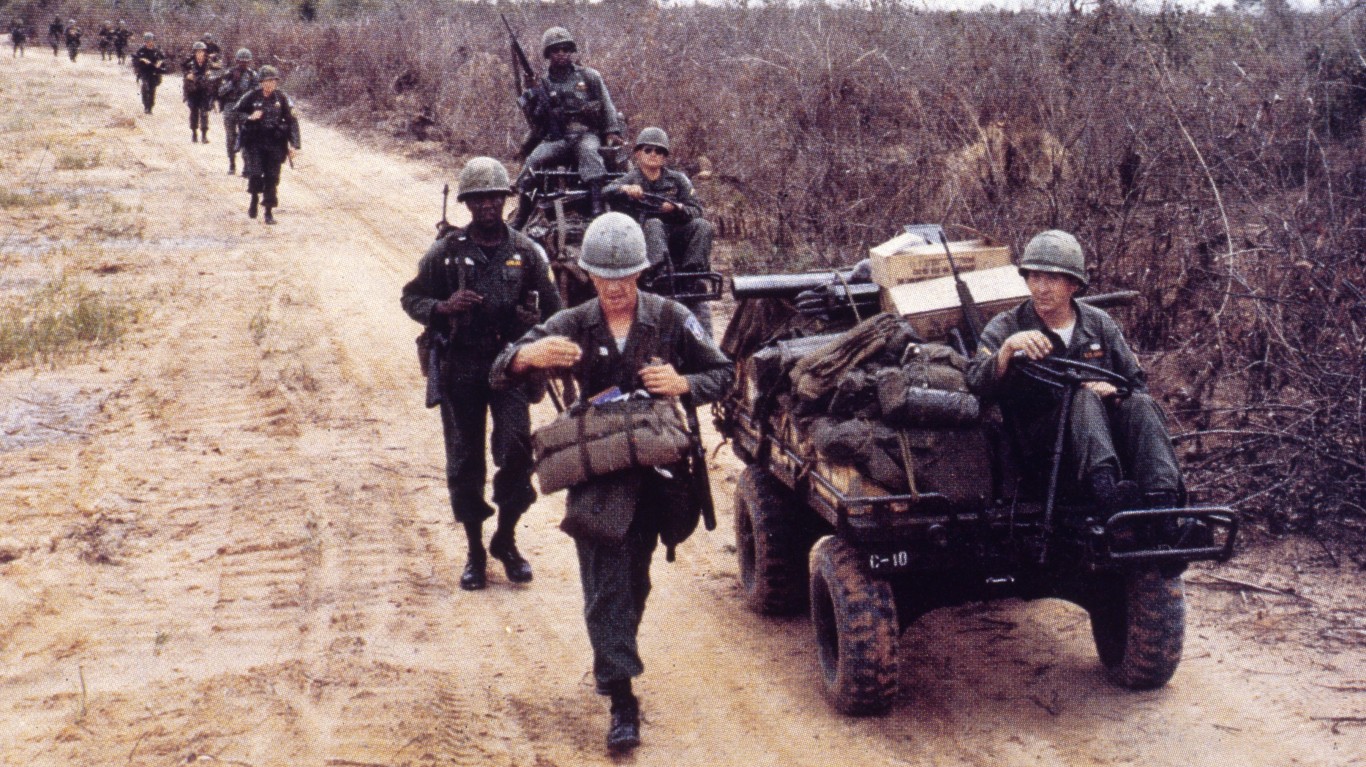
8. Vietnam War (1965-1975)
> Headwear: Initially, headwear was similar to that used in World War II, but by mid-war, new liners of ballistic nylon replaced the older liners. Many troops also wore reversible cotton camouflage covers over their helmets, with green colors on one side and brown on the other. Buttonholes in the covers could be used to insert real foliage for additional camouflage. Some soldiers also wore an olive green tropical hat, or boonie hat, which was a flat top with a circular 2.5-inch brim and an adjustable nylon chin strap.
> Clothing: Troops wore jungle fatigues, which were lighter for the tropical climate. The tropical combat jacket had two slanted breast pockets and two lower pockets. The utility shirt worn in Vietnam, between 1965 and 1967, was olive green and had two patch chest pockets. Trousers were cotton and had side cargo pockets and drawstrings at the bottom to protect from insects. Unlike the infantry, who wore solid green, Special Forces troops wore ERDL camouflage, or “leaf” pattern camouflage.
> Footwear: During the Vietnam War, the military began issuing tropical combat boots, which were made of canvas rather than leather for better breathability. The rubber sole was reinforced with steel plates to reduce the likelihood of injury from wooden or bamboo spikes.
> Other equipment: Americans fighting in Vietnam initially wore M1952A fragmentation protective vests, a holdover from the Korean War, and later switched to an improved M1969 fragmentation protective vest. They also carried the waterproof M1961 combat field pack strapped to their pistol belt, a first aid and compass case, a plastic canteen and stainless steel cup, an entrenching tool, and a sleeping bag.
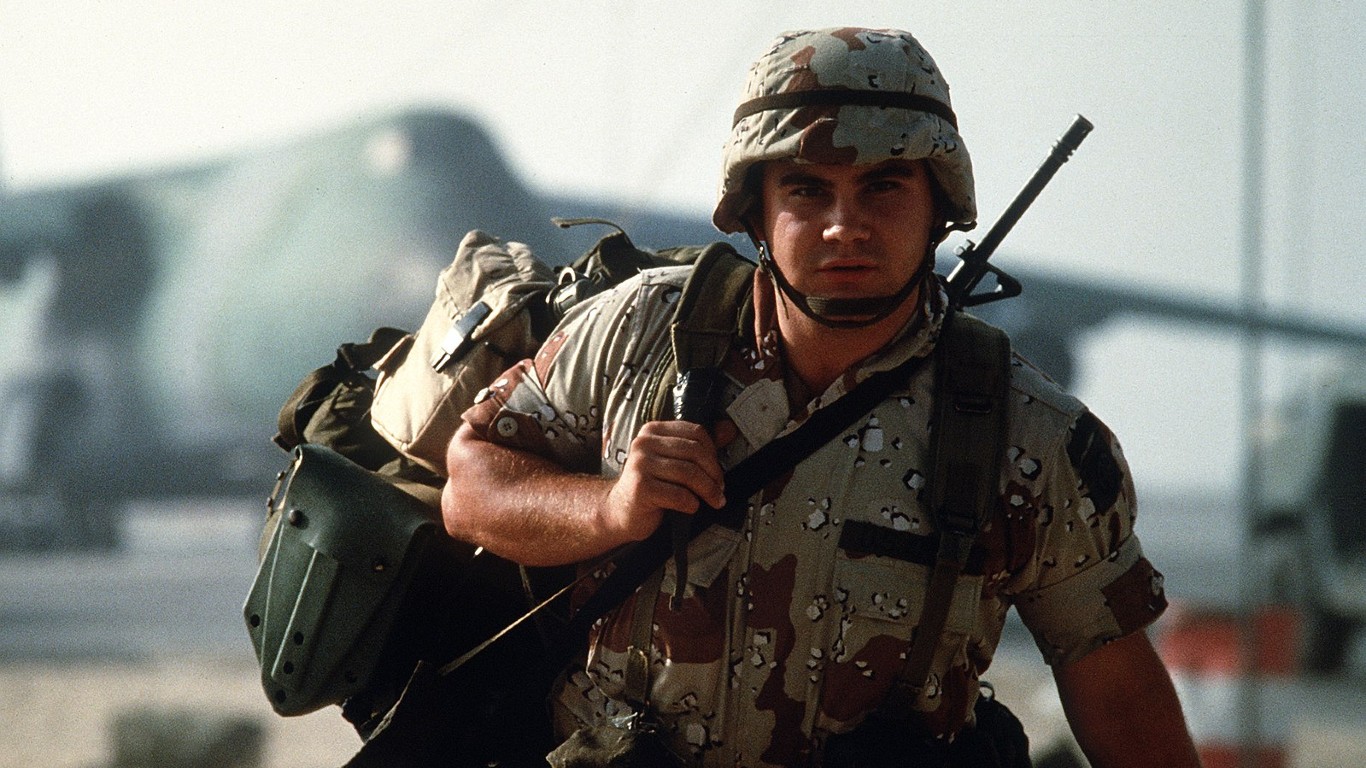
9. Desert Storm (1990-1991)
> Headwear: In the Gulf War, American troops wore a helmet made of ballistic fiberglass, or Kevlar, which protected them not only from shrapnel but also some bullets. Helmets were covered with camouflage and had ear protection. Compared to previous helmets, they had improved visibility and a smaller profile.
> Clothing: In this era, the U.S. military wore desert camouflage, commonly referred to as “chocolate chip” camouflage. Battle dress uniforms featured a lightweight coat with four straight pockets with button flaps, and matching pants with slanted front pockets, rear pockets with flaps, cargo pockets on the side, and drawstrings on the bottom.
> Footwear: Black leather boots and olive- or tan-colored nylon-canvas and leather jungle and desert boots were commonly worn by American servicemen and women.
> Other equipment: Ground troops of the era wore a fragmentation protective vest. Also made of Kevlar, these vests were capable of stopping lower velocity shrapnel, but not high-velocity bullets. They also wore all-purpose lightweight individual carrying equipment, or ALICE, which was a Y-shaped pair of nylon suspenders for carrying gear, including an M17A2 gas mask.
[in-text-ad-2]

10. Operation Enduring Freedom/Operation Iraqi Freedom (2000s)
> Headwear: At first, headgear was similar to that used in Desert Storm, but also incorporated woodland pattern camouflage to accommodate different landscapes. Later, the military adopted the new advanced combat helmet, which reduced weight by eliminating portions of eye and ear coverings. It featured a four-point chin strap, greater head mobility, and improved bullet protection, and could be used in tandem with tactical headsets, microphones, and night vision goggles. Many soldiers also wore military combat eye protection, which protected not only against dust, wind, and ultraviolet rays, but also shrapnel and lasers.
> Clothing: In this era, the U.S. Army was using the three-color desert camouflage uniform, made from a 50/50 cotton-nylon blend. before switching to the universal camouflage pattern. They also wore flame-retardant gloves and the bullet-stopping body armor known as the outer tactical vest. In the later 2000s, shirts and trousers had reinforced knees and elbows, and troops also wore knee and elbow pads.
> Footwear: The U.S. Army adopted a new desert-colored jungle boot made of nylon and leather. Footwear was later upgraded to the army combat boot for use in temperate weather. Lightweight and breathable, these nylon boots were also waterproof and fireproof.
> Other equipment: Soldiers in Iraq and Afghanistan were issued the modular lightweight load-carrying equipment system in the universal camouflage pattern. It featured a main pack with meal pouches and an external frame sleeping bag compartment, as well as a load bearing vest and butt pack. With this system, soldiers could carry gear like canteens, ammunition, and first aid kits in whatever configuration they preferred. Soldiers could also use a CamelBak Hydration Bladder in their pack with a hose and bite valve to drink water while moving.
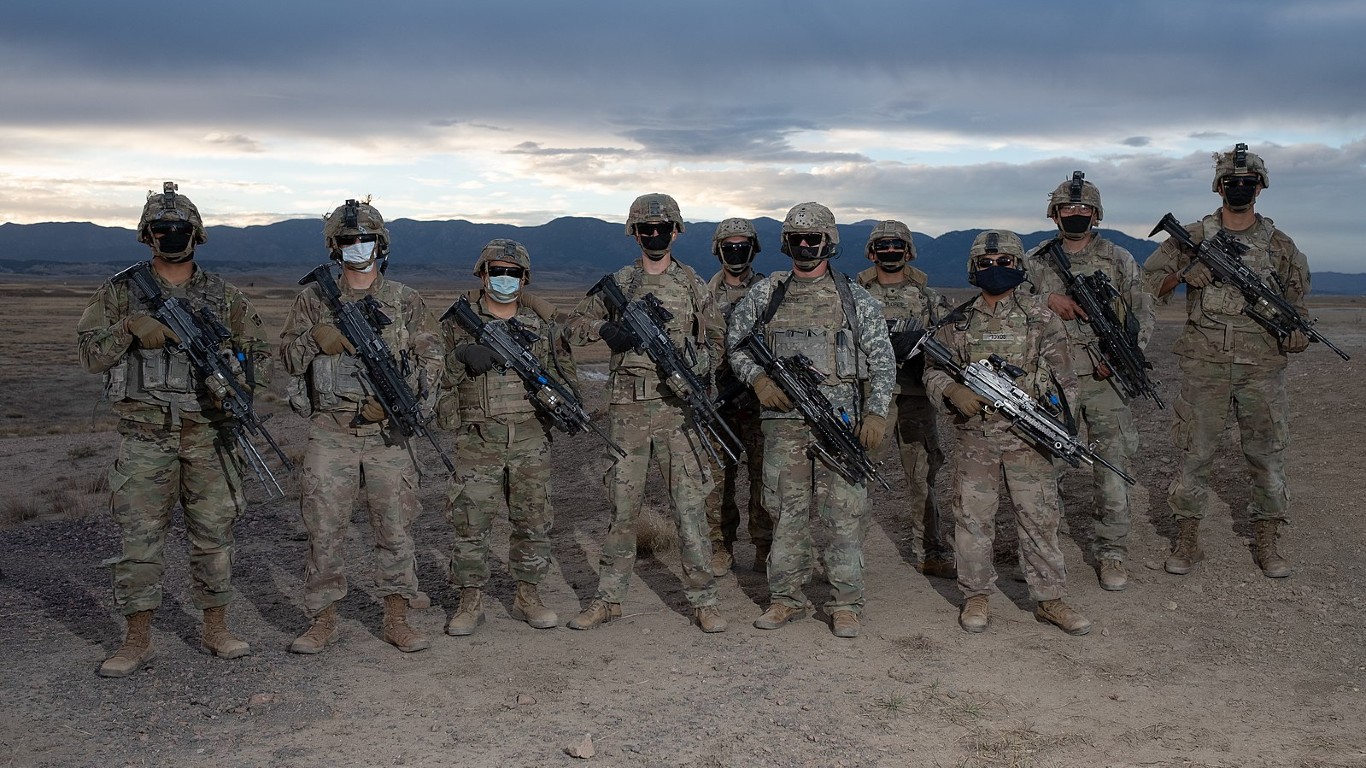
11. Modern Era (2019-2021)
> Headwear: In the modern era, the U.S. military still uses the advanced combat helmet of the previous decade.
> Clothing: Clothing now used in the U.S. military incorporates flame-retardant material infused with permethrin to protect from insect-borne diseases. The operational camouflage pattern is now used in the army combat uniform coat, which has two slanted breast pockets and cargo pockets on the sleeves, as well as the army combat uniform shirt and trousers, which have been upgraded to better regulate body temperature when wearing armor and have reinforced areas to improve wear.
> Footwear: Today, troops still wear the army combat boot.
> Other equipment: Since 2018, troops have worn the modular scalable vest, which is lighter weight than previous bullet-resistant vests and can be modified to meet specific mission requirements. Troops also wear the MOLLE II medium rucksack.
After two decades of reviewing financial products I haven’t seen anything like this. Credit card companies are at war, handing out free rewards and benefits to win the best customers.
A good cash back card can be worth thousands of dollars a year in free money, not to mention other perks like travel, insurance, and access to fancy lounges.
Our top pick today pays up to 5% cash back, a $200 bonus on top, and $0 annual fee. Click here to apply before they stop offering rewards this generous.
Flywheel Publishing has partnered with CardRatings for our coverage of credit card products. Flywheel Publishing and CardRatings may receive a commission from card issuers.
Thank you for reading! Have some feedback for us?
Contact the 24/7 Wall St. editorial team.